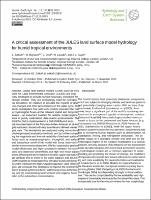Mostrar el registro sencillo del ítem
A critical assessment of the JULES land surface model hydrology for humid tropical environments
| dc.contributor.author | Zulkafli, Z. | |
| dc.contributor.author | Buytaert, W. | |
| dc.contributor.author | Onof, C. | |
| dc.contributor.author | Lavado-Casimiro, W. | |
| dc.contributor.author | Guyot, J.L. | |
| dc.date.accessioned | 2019-07-26T06:40:35Z | |
| dc.date.available | 2019-07-26T06:40:35Z | |
| dc.date.issued | 2013-01 | |
| dc.identifier.uri | http://repositorio.senamhi.gob.pe/handle/20.500.12542/64 | |
| dc.description.abstract | Global land surface models (LSMs) such as the Joint UK Land Environment Simulator (JULES) are originally developed to provide surface boundary conditions for climate models. They are increasingly used for hydrological simulation, for instance to simulate the impacts of land use changes and other perturbations on the water cycle. This study investigates how well such models represent the major hydrological fluxes at the relevant spatial and temporal scales-an important question for reliable model applications in poorly understood, data-scarce environments. The JULES-LSM is implemented in a 360 000 km2 humid tropical mountain basin of the Peruvian Andes-Amazon at 12-km grid resolution, forced with daily satellite and climate reanalysis data. The simulations are evaluated using conventional discharge-based evaluation methods, and by further comparing the magnitude and internal variability of the basin surface fluxes such as evapotranspiration, throughfall, and surface and subsurface runoff of the model with those observed in similar environments elsewhere. We find reasonably positive model efficiencies and high correlations between the simulated and observed streamflows, but high root-mean-square errors affecting the performance in smaller, upper sub-basins. We attribute this to errors in the water balance and JULES-LSM's inability to model baseflow. We also found a tendency to under-represent the high evapotranspiration rates of the region. We conclude that strategies to improve the representation of tropical systems to be (1) addressing errors in the forcing and (2) incorporating local wetland and regional floodplain in the subsurface representation. | en_US |
| dc.format | application/pdf | |
| dc.language.iso | eng | en_US |
| dc.publisher | Hydrology and Earth System Sciences (HESS) | en_US |
| dc.relation.ispartof | urn:issn:1027-5606 | |
| dc.rights | info:eu-repo/semantics/openAccess | es_PE |
| dc.rights | Attribution-NonCommercial-ShareAlike 3.0 United States | * |
| dc.rights.uri | http://creativecommons.org/licenses/by-nc-sa/3.0/us/ | * |
| dc.source | Servicio Nacional de Meteorología e Hidrología del Perú | es_PE |
| dc.source | Repositorio Institucional - SENAMHI | es_PE |
| dc.subject | Critical assessment | en_US |
| dc.subject | Global land surface | en_US |
| dc.subject | Hydrological simulations | en_US |
| dc.subject | Internal variability | en_US |
| dc.subject | Land surface models | en_US |
| dc.subject | Root-mean square errors | en_US |
| dc.subject | Surface boundary conditions | en_US |
| dc.subject | Tropical environments | en_US |
| dc.title | A critical assessment of the JULES land surface model hydrology for humid tropical environments | en_US |
| dc.type | info:eu-repo/semantics/article | en_US |
| dc.identifier.isni | 0000 0001 0746 0446 | |
| dc.description.peerreview | Por pares | |
| dc.identifier.doi | https://doi.org/10.5194/hess-17-1113-2013 | |
| dc.source.volume | 17 | es_PE |
| dc.source.issue | 3 | es_PE |
| dc.source.initialpage | 1113 | es_PE |
| dc.source.endpage | 1132 | es_PE |
| dc.source.journal | Hydrology and Earth System Sciences | es_PE |
| dc.subject.sinia | gestion de recursos hidricos de cuenca - Agua | |
| dc.type.sinia | text/publicacion cientifica | |
| dc.identifier.url | https://hdl.handle.net/20.500.12542/64 |
Ficheros en el ítem
Este ítem aparece en la(s) siguiente(s) colección(es)
-
Artículo científico [171]









